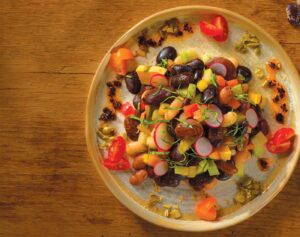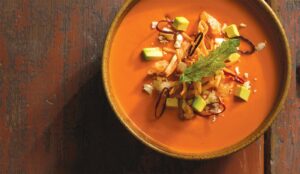
Legume lessons from grandma, simmered with intention
PHOTOGRAPHY BY PATRICK TREGENZA
The thread that connects cooking and wisdom is short.
In my Mexican homeland, when you pull on that thread, it comes out in dichos.
That’s Spanish for “sayings,” little bites of knowledge, which carry mini-doctrines, often with a touch of humor, and are easy to digest and can resonate across generations.
Maybe the grandkids will quote yours when the occasion is right. I often use a few from my abuelita, including “El que nace para tamal del cielo le caen las hojas.”
Taken literally, it means, “If you are born to be a tamale, leaf wrappers will fall from heaven.”
The insight boiled in: When you are doing something you are meant to do, things have a way of dropping into place. Beans, like dichos, enjoy a lot of diversity, history and Mexican heritage.
They were among the first plants to be domesticated in North and South America.
Spanish chroniclers detail how the bean plant was consumed in its entirety, including the root, flowers and fresh pods, while the seeds—both fresh and dried—were cooked whole or finely ground.
Throughout Mexico’s history, even as influences arrived from the rest of the world, beans have retained their character and remained a staple of every household and meal, regardless of region or status.
That’s partly because they are rich in fiber, protein and minerals. And because they are delicious.
Here are three dichos that apply when it comes to understanding— and preparing—incredible beans.
BUEN RECAUDO HACE COCINA.
Literal translation: Good ingredients make good cooking.
Figurative lesson: It’s helpful to start a project with great people, materials and ideas.
Beans thrive from deserts to tropical jungles. Species can derive their names from their color or size, such as negros (black), bayos (cream), ayocote (large) or pinto (variegated). They may also be named after their place of origin—for example, peruanos—or the season in which they bloom, such as flor de mayo.
Although higher yield and disease resistance generally dictate which varieties are most widely available, organic heirloom beans have seen a resurgence in the last few decades.
Steve Sando, founder of Rancho Gordo gourmet grocers, has embarked on an amazing labor-of-love crusade to rescue and promote them.
He and many other dedicated growers are collecting seeds from small towns in Mexico, providing the opportunity to experience the diverse qualities and nuances of these colorful high-protein seeds.
They’re worth seeking out.
Only the pot knows what’s simmering in its broth.
DEL PLATO A LA BOCA, SE CAE LA SOPA.
Literal translation: Soup may spill on its way from plate to mouth.
Figurative lesson: Not everything turns out as expected.
The nice thing about beans is that they’re relatively easy. But there are some guidelines to keep in mind—including sorting out bad beans and stirring mindfully to avoid burnt and/or uneven results—and ways to adapt preparation as it’s happening to improve the flavor of the ultimate result.
The simple starting point for a great batch can be the frijoles de la olla approach—also known as parados, or “standing,” aka ready to go—in a pot.
Brothy and neutral, they are easy to freeze and open any number of bean-based culinary journeys.
Pick out any debris such as twigs or pebbles or broken beans. Soaking is not necessary unless it is an older crop. If you don’t have a clay pot, any heavy pot large enough to hold them comfortably will do.
Flavor can come from epazote, bay or avocado leaves added to start or as a finish.
Onion, garlic, oregano or cumin enhance the flavor, depending on the region. To play the European card, add onion with a couple of cloves, carrots and a celery stick as well.
There are no set rules. Start with the simplest flavors and build from that, keeping in mind that lighter-colored varieties have milder flavors. If it is a flavorful and recently harvested seed, simply cook in water, using 6–8 cups of water per cup of beans. Bring up to a healthy boil, then simmer until soft. That’s when you add salt. Be generous.
SOLO LA OLLA SABE LOS HERVORES DE SU CALDO.
Literal translation: Only the pot knows what’s simmering in its broth.
Figurative lesson: A person’s experience is personal and unique; we can always be more empathic.
To finish a batch of beans, this is the family trick that rounds up flavor with a smoky hint: Fry a slice of onion until it is caramel brown in a few tablespoons of a neutral vegetable oil or even lard if you’re feeling brave. Stir into the beans.
Serve with cilantro, tomato, onion, queso fresco or goat cheese, cream, fried chorizo, sliced chiles, lime…anything goes.
From the frijoles de la olla base you can purée, refry, strain, scramble, turn it into soup, sauce, or just scoop up with a folded tortilla.
The list of regional specialties is endless.
In Yucatan, where black beans rule, Fridays traditionally are laundry days and there is always a large pot of beans simmering with pork ribs and aromatics for frijol con puerco, to be served with radish, onion, oregano, cilantro and habanero. A complete meal that practically cooks itself.
Northern states prefer lighter beans—combined with beer, chorizo and chile they become borrachos, or rancheros.
So much to explore, but that would violate a different dicho: Al caramelo y al asunto, a darles punto.
Literal translation: Cook caramel to the right point.
Figurative lesson: Know when caramel, and the story, are done.


About the author
Analuisa Béjar loves exploring flavor routes as the chef at her Sunny Bakery Cafe in Carmel Valley. She is a recent transplant from Mexico City, where she was a food critic, award-winning writer, editor, recipe developer, culinary teacher and organizer of Latin American gastronomy competitions.
- Analuisa Béjarhttps://www.ediblemontereybay.com/author/analuisabejar/
- Analuisa Béjarhttps://www.ediblemontereybay.com/author/analuisabejar/
- Analuisa Béjarhttps://www.ediblemontereybay.com/author/analuisabejar/
- Analuisa Béjarhttps://www.ediblemontereybay.com/author/analuisabejar/


